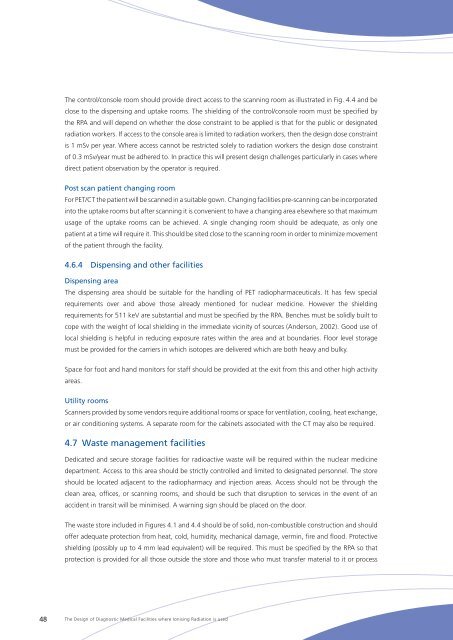The Design of Diagnostic Medical Facilities where ... - ResearchGate
The Design of Diagnostic Medical Facilities where ... - ResearchGate
The Design of Diagnostic Medical Facilities where ... - ResearchGate
You also want an ePaper? Increase the reach of your titles
YUMPU automatically turns print PDFs into web optimized ePapers that Google loves.
<strong>The</strong> control/console room should provide direct access to the scanning room as illustrated in Fig. 4.4 and be<br />
close to the dispensing and uptake rooms. <strong>The</strong> shielding <strong>of</strong> the control/console room must be specified by<br />
the RPA and will depend on whether the dose constraint to be applied is that for the public or designated<br />
radiation workers. If access to the console area is limited to radiation workers, then the design dose constraint<br />
is 1 mSv per year. Where access cannot be restricted solely to radiation workers the design dose constraint<br />
<strong>of</strong> 0.3 mSv/year must be adhered to. In practice this will present design challenges particularly in cases <strong>where</strong><br />
direct patient observation by the operator is required.<br />
Post scan patient changing room<br />
For PET/CT the patient will be scanned in a suitable gown. Changing facilities pre-scanning can be incorporated<br />
into the uptake rooms but after scanning it is convenient to have a changing area else<strong>where</strong> so that maximum<br />
usage <strong>of</strong> the uptake rooms can be achieved. A single changing room should be adequate, as only one<br />
patient at a time will require it. This should be sited close to the scanning room in order to minimize movement<br />
<strong>of</strong> the patient through the facility.<br />
4.6.4 Dispensing and other facilities<br />
Dispensing area<br />
<strong>The</strong> dispensing area should be suitable for the handling <strong>of</strong> PET radiopharmaceuticals. It has few special<br />
requirements over and above those already mentioned for nuclear medicine. However the shielding<br />
requirements for 511 keV are substantial and must be specified by the RPA. Benches must be solidly built to<br />
cope with the weight <strong>of</strong> local shielding in the immediate vicinity <strong>of</strong> sources (Anderson, 2002). Good use <strong>of</strong><br />
local shielding is helpful in reducing exposure rates within the area and at boundaries. Floor level storage<br />
must be provided for the carriers in which isotopes are delivered which are both heavy and bulky.<br />
Space for foot and hand monitors for staff should be provided at the exit from this and other high activity<br />
areas.<br />
Utility rooms<br />
Scanners provided by some vendors require additional rooms or space for ventilation, cooling, heat exchange,<br />
or air conditioning systems. A separate room for the cabinets associated with the CT may also be required.<br />
4.7 Waste management facilities<br />
Dedicated and secure storage facilities for radioactive waste will be required within the nuclear medicine<br />
department. Access to this area should be strictly controlled and limited to designated personnel. <strong>The</strong> store<br />
should be located adjacent to the radiopharmacy and injection areas. Access should not be through the<br />
clean area, <strong>of</strong>fices, or scanning rooms, and should be such that disruption to services in the event <strong>of</strong> an<br />
accident in transit will be minimised. A warning sign should be placed on the door.<br />
<strong>The</strong> waste store included in Figures 4.1 and 4.4 should be <strong>of</strong> solid, non-combustible construction and should<br />
<strong>of</strong>fer adequate protection from heat, cold, humidity, mechanical damage, vermin, fire and flood. Protective<br />
shielding (possibly up to 4 mm lead equivalent) will be required. This must be specified by the RPA so that<br />
protection is provided for all those outside the store and those who must transfer material to it or process<br />
48<br />
<strong>The</strong> <strong>Design</strong> <strong>of</strong> <strong>Diagnostic</strong> <strong>Medical</strong> <strong>Facilities</strong> <strong>where</strong> Ionising Radiation is used
















